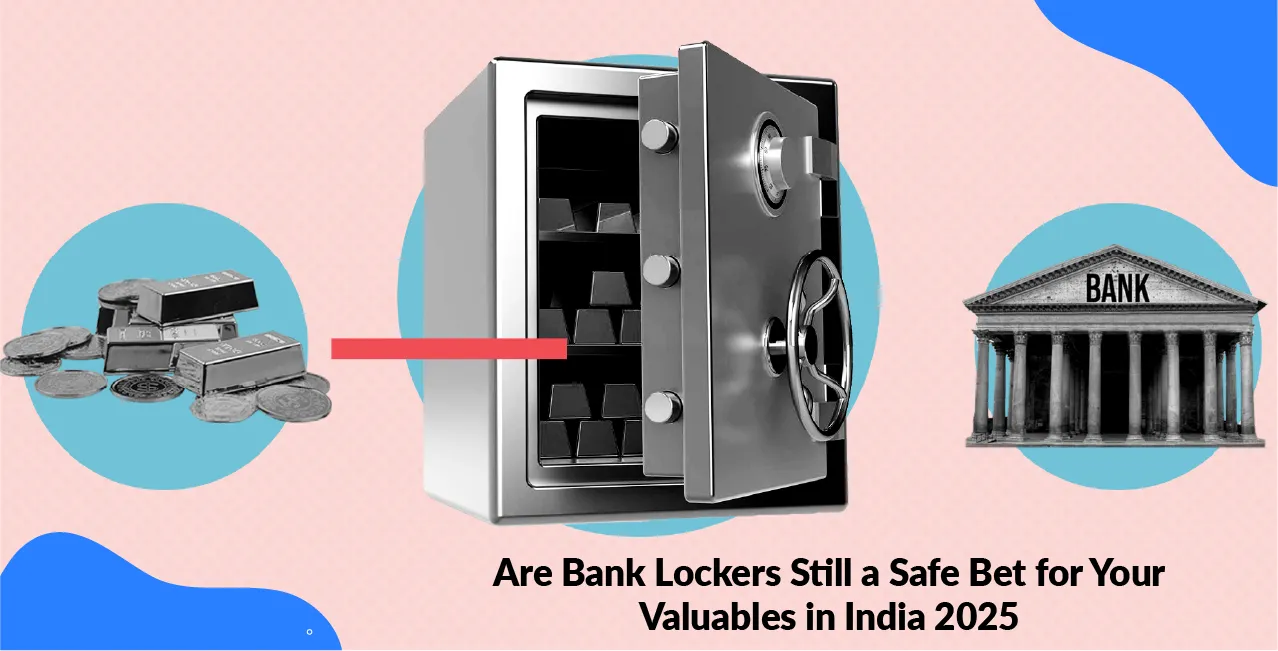
Author
LoansJagat Team
Read Time
5 Min
11 Jul 2025
Are Bank Lockers Still a Safe Bet for Your Valuables in India 2025? Alternatives Explored
Bank lockers were once considered the ultimate safe haven for precious belongings in India. Recent shocking theft cases and severely limited compensation schemes are changing this perception completely. Millions of Indians are now questioning their traditional trust in conventional banking security solutions for valuable storage.
1. Recent locker thefts highlight vulnerabilities
Bank lockers in India face increasing vulnerabilities despite traditional trust. Recent incidents include the arrest of a former SBI employee in Koraput for stealing gold from lockers, and the arrest of 13 people, including managers, for jewellery theft in Jharkhand. The Reserve Bank of India reported over 13,000 bank fraud cases in 2024. Like the famous heist in Bollywood's "Special 26", modern locker thefts expose systematic weaknesses.
Under current regulations, banks only compensate 100 times the annual locker rent for theft due to negligence. This creates significant financial gaps for customers storing valuable items.
Case Study: Tarun's Locker Analysis
Tarun faces potential losses of ₹6.5 lakh beyond compensation. Modern alternatives like home safes with insurance, digital document storage, and diversified storage locations offer better protection than traditional bank lockers alone.
2. Banks are held liable—but compensation is limited
The Reserve Bank of India holds banks responsible for locker safety, but compensation remains severely restricted under current guidelines. Banks must pay up to 100 times the annual locker rent if valuables are stolen due to fire, building collapse, or bank negligence. However, banks are not liable for damages from natural calamities or customer negligence. This creates substantial financial gaps between actual losses and compensation received.
The liability framework protects banks more than customers. Many locker holders discover too late that their expensive jewellery and documents receive minimal compensation despite paying premium rental fees. Insurance companies often refuse coverage for items stored in bank lockers, assuming banks provide adequate protection.
Rahul's Compensation Analysis
Rahul's analysis reveals that expensive items remain largely unprotected. The compensation formula fails to match inflation and rising gold prices, leaving substantial financial risk.
Read More – How to Invest in Gold
3. Growing customer dissatisfaction
Bank lockers in India face mounting criticism from customers who feel betrayed by inadequate security measures and limited compensation schemes. Recent RBI guidelines mandate banks to compensate customers only 100 times the annual rent for theft or damage, which often falls short of actual losses.
Multiple instances of theft from bank lockers have emerged, creating widespread concern amongst customers. The saying "doodh ka jala chaach bhi phoonk kar peeta hai" perfectly captures customers' cautious approach towards bank lockers nowadays.
Lokesh's Bank Locker Loss Example
Despite regulations requiring CCTV surveillance and proper documentation, customers like Lokesh discover that compensation rarely covers their actual losses, leading to growing dissatisfaction with traditional banking security solutions.
4. Rental costs vary widely by bank & location
Bank locker rental charges in India differ significantly across institutions and geographical locations. Rental costs typically range from ₹1,200 to ₹22,000 annually, depending on the bank, locker size, and branch location. SBI charges ₹1,500 plus GST for small lockers in urban areas but only ₹1,000 plus GST in rural locations. Private banks generally charge higher rates than public sector banks. HDFC Bank charges ₹550 for extra small lockers in rural areas, whilst metropolitan branches command premium pricing.
Shivam's Bank Locker Cost Comparison
This variation creates substantial cost differences for customers like Shivam, who must carefully evaluate location-specific pricing structures before selecting banking partners for their valuable storage requirements.
5. Modern secure alternatives are emerging
Modern secure alternatives to traditional bank lockers are revolutionising the storage of valuables in India. Smart Vault technology offers fully automated robotic lockers available 24*7, seven days a week. Private vaults provide robust security measures including 24/7 surveillance, controlled access, and environmental controls to protect against fire and water damage. Companies like Kothari Safe Vaults, Sakthi Safe Vaults, India Safety Vaults offer services ranging from ₹1,000-6,000. Digital storage solutions and home safes provide additional flexibility for modern consumers.
Paras's Security Options Comparison
Also Read - SBI Locker Charges
These alternatives offer enhanced security features, better accessibility, and improved customer service compared to conventional banking solutions.
Conclusion
Bank lockers in India may not be the safest choice now due to theft risks and low compensation. Modern options like private vaults or home safes offer better security and coverage.
FAQs
1. Are bank lockers safe for valuables in India?
No, recent thefts and low compensation make them risky.
2. How much will banks pay if my locker is robbed?
Only 100 times the annual rent, which is often too low.
3. What are better options than bank lockers?
Private vaults, home safes with insurance, or digital storage.
4. Do banks cover losses from natural disasters?
No, banks are not liable for damage from floods or earthquakes.
About the Author

LoansJagat Team
‘Simplify Finance for Everyone.’ This is the common goal of our team, as we try to explain any topic with relatable examples. From personal to business finance, managing EMIs to becoming debt-free, we do extensive research on each and every parameter, so you don’t have to. Scroll up and have a look at what 15+ years of experience in the BFSI sector looks like.

Quick Apply Loan
Subscribe Now
Related Blog Post


